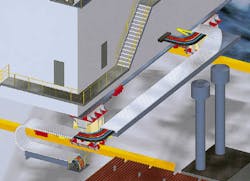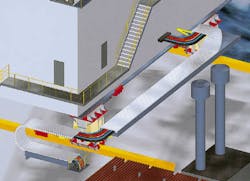Subsea/Surface Systems Technology
William Furlow
Houston
The new cantilever drill floor design from Marine Structure Consultants uses a fixed drill floor and a cantilever that will move longitudinally and transversely.
Water column tops list of US Gulf deepwater challenges
In a recent speech before the American Petroleum Institute, BP/Amoco Business Unit Leader, Deepwater GOM Exploration Steve Peacock presented an inclusive listing of the challenges and potential solutions the industry will face as it moves into ultra-deepwater in the US Gulf of Mexico.Topping the list of challenges is the water column. Peacock said water depth is only one aspect of this challenge. New exploration will have to deal with the threat of hurricanes in the Gulf of Mexico, as well as the loop currents. Both the greater water depth and the increased distance from shore enhance these hazards.
Solutions currently under development or consideration for dealing with these water column hazards are floating production, storage, and offloading (FPSO) vessels, new generations of semisubmersible drilling rigs, preset mooring systems that hold vessels on station in deeper water, and the riserless drilling system that would combat the effects of the extremely heavy water column on drilling programs.
On the seabed itself, Peacock identified several difficulties associated with the topography and soil composition at the mudline. Problems include unstable conditions in these newly formed sediments, steep slopes that hamper subsea production and pipelay designs, and the high pressures/extreme depth of this environment. Solutions must be found in the areas of pipeline design and lay methods, as well as chemosynthetic management.
In the shallow sections of the well, drillers must address shallow water flows and shallow gas hazards. To overcome these threats new cementing technology and greater experience drilling in this environment are needed.
Another area of concern in the Gulf of Mexico deepwater region is the presence of a huge subsurface salt shelf. It is difficult to image through this salt, so drillers never are certain what they face below the salt. Also, there is typically an overpressured disturbed zone below the salt that creates extremely narrow drilling margins. Greater advancements in 3D seismic imaging and more advanced mud programs could help mitigate the threat of salt in deepwater.
In deep formations, pore pressures run high and it is often difficult to get clear images of what drillers are facing in these deep rocks. Advances in seismic while drilling technology help identify deep-lying formations and aid with pressure predictions. Expandable casing technology has the potential to offer drillers an alternative to traditional casing programs that would allow the setting of multiple strings through problem zones without the rapid loss of internal diameter (ID).
In the area of extraction, well deliverability and drainage are key to making early returns on investments. Because of the high costs in deepwater and ultra-deepwater, it is essential that there is a rapid and robust return in the form of high early production numbers. On the flipside, better completion technology does not just guarantee high numbers early on, but effective and thorough drainage of the reservoir.
For Peacock, the bottom line is planning. Multidisciplinary teams can attack problems with a host of solutions drawn from a variety of technologies and experiences. Using computer technology to visualize everything from the drill floor to a subsalt formation allows planners to run simulations and identify potential problems before finalizing a project.
Sea Producer buoy for subsea production
Ocean Resources out of the UK has developed a low-cost concept for producing marginal fields. The Sea Producer is a large processing buoy connected to a gravity base by tensioners. The structure is about 60 meters tall. Only a 2-meter access line is visible from the surface. All of the power and processing units are below the water line. Because the bulk of the 18-meter diameter buoy rests below the surface, it is a viable solution for hostile environments such as the Central North Sea.Ocean Resources Managing Director Phil Hands said the concept was developed with the support of several UK operators interested in a production solution for projects in the Central North Sea that were nearing their end of field life. Ocean Resources recently signed a cooperation agreement with Mentor Subsea to market these solutions in the US. According to Hands, J. Ray McDermott believes it can reduce the cost of manufacturing the buoy by building it in the US or possibly Mexico. In addition to cheaper manufacturing and steel costs, the regulatory restrictions are looser, making it less expensive.
While the Sea Producer would cost as much as $45 million if built in the UK, McDermott hopes to build this buoy for under $20 million. If this were possible, the buoy would offer an economic solution for smaller and end of field life projects in the US Gulf of Mexico.
Currently, a smaller version of the Sea Producer concept is in place on the Mossgas operated EM field off of South Africa's Muscle Bay area. The buoy can provide water injection, separation, and storage for smaller fields in water depths between 65 meters and 1,800 meters. It is taut-moored into a concrete gravity base, which can also store up to 500,000 bbl of oil. The Sea Producer solution is far less expensive than either a fixed bottom platform or an FPSO. It can handle production from 20,000 to 50,000 b/d.
New cantilever design offers increased flexibility
Marine Structure Consultants has developed a new cantilever drill floor design that eliminates many of the weaknesses in conventional cantilever systems. By incorporating a fixed drill floor and a cantilever that moves both longitudinally and transversely on support rails on the jackup hull, the design eliminates the need for flexible hoses and cable units connecting the cantilever and the drill floor. The high pressure (HP) mud pumps are located on the cantilever, rather than in the jackup hull, and the fixed HP piping runs are located between the mud pumps and the drill floor.The cantilever is split up into two parts. The aft section includes the BOP equipment arranged within it and the drill floor fixed to it. The forward section is supported by the hull and connected to the aft section. When it is necessary to install the drill floor on a fixed platform, the aft part of the cantilever with the drill floor fitted on top of it is disconnected from the forward part and installed on the fixed platform, eliminating the need for a separate structure.
Copyright 1999 Oil & Gas Journal. All Rights Reserved.

